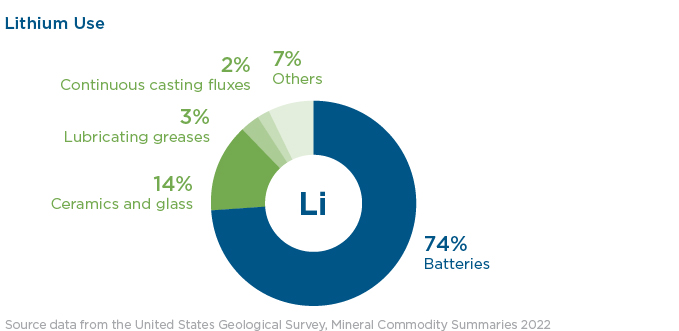Updated June 2023
What is Lithium
Lithium is considered the lightest of all metals and the lightest solid element under standard conditions. Lithium is a soft, silvery-white metal that is highly flammable and reactive. It does not naturally occur as a pure element but in compounds, usually ionic compounds in mineral deposits, including brines or salts.
Globally, most lithium is produced by the precipitation of lithium-containing salts from shallow underground brine reservoirs using large evaporation ponds or by mining lithium-containing rocks, such as spodumene ore. Lithium extraction and processing methods vary depending on the source material. Alternative production methods include extraction from clay, seawater, geothermal brines, oil and gas field brines, and recycled electronics.
In Alberta, lithium is dissolved in deep-formation waters that coexist in oil and gas reservoirs. Based on current geological knowledge, the areas with the most potential are Devonian-aged carbonate reservoirs in northwestern and central Alberta. The Alberta Geological Survey is currently undertaking a program to expand the publicly available geoscience data for emerging resources, including lithium, to improve our understanding of the province’s mineral resource potential.
Companies and research groups in Alberta are testing direct lithium extraction (DLE) technology. This technology allows access to Alberta's lithium-brine potential found in many existing oil and gas reservoirs.
Batteries for electronics and electric vehicles drive global lithium demand, followed by ceramics and glass. The following figure shows the primary uses of lithium as of 2022.

Demand for electric vehicles (EVs) powered by lithium-ion batteries is projected to increase. Consumers are incentivized to purchase EVs because of improving battery technology, massive EV production, lower cost of fuel, and more stringent hydrocarbon environmental policies.
Federal and Provincial Critical Minerals Strategy
The federal government has included lithium on Canada's critical mineral list due to its role in economic security and transitioning to a low-carbon economy. Critical minerals are vital to growing Canada's clean, modern economy and are essential for clean technology applications, renewable energy, defence and security technologies, agriculture, and medical applications.
Alberta's lithium plan aligns with the federal government strategy. As Alberta's Recovery Plan sets out, Alberta is committed to establishing a new mineral strategy to leverage its lithium deposits. Alberta’s mineral strategy and action plan was released in November 2021. The plan was developed with input from stakeholders and Indigenous peoples. The Government of Alberta has expanded the mandate of the Alberta Energy Regulator (AER) to include minerals as a new growth area. The Mineral Resource Development Act (MRDA) establishes the AER as the sole regulator of mineral resources. Alberta has extensive geological data and existing infrastructure to enable access to reservoirs and unlock Alberta's lithium production potential to capitalize on increasing demand.
Production in 2022 and Forecast
Based on our preliminary analysis, there is no lithium production in Alberta in 2022. However, E3 Lithium is advancing plans for commercial production in 2026 of 4.4 thousand tonnes of lithium from 11 producing wells. The production and well forecasts involve weighing the risks based on the likelihood of the project meeting its operational date and production capacity. Total lithium production in Alberta is forecast to rise to 7.6 thousand tonnes by 2032 (see Figure S9.4).
Potential uses of lithium in Alberta include industrial applications, such as the chemical production of lithium carbonate and lithium hydroxide, mainly used in manufacturing modern battery technology.
Projects
Several companies in Alberta have announced projects:
- E3 Lithium has announced it has commissioned its Calgary-based testing facility.
- Neolithica has announced the construction of a demonstration pilot plant for DLE from brine. The demonstration pilot will be situated between Peace River and Grande Prairie and is expected to be operational in 2024.
- Highwood's Drumheller Li-Brine project is an early-stage exploration project with a two-phased program: technology development and preparation of a preliminary economic assessment report.
Limitations or Risks to the Outlook
Lithium extraction costs are expected to be lower in the future. Lithium production is expected to become competitive as new extraction methods are developed and proven scalable, and infrastructure is available in the coming years. The economics of the lithium industry depend on climate change policies, technology development, financial support, and associated risks. Risks include disruptive technologies, concentrated supply chains, and potentially volatile markets. Several actions can be taken to improve lithium economics and reduce investment risks:
- Develop clear policies and regulations.
- Design advanced extractive technologies.
- Ensure responsible mining and high environmental, social, and corporate governance (ESG) standards to attract investors.
- Establish infrastructure and supply chains.
Learn More
- Methodology
- Data [lXLSX]
- By Topic > Emerging Resources
- AGS > Critical Minerals Potential
- AGS > AER/AGS Open File Report 2021-04


